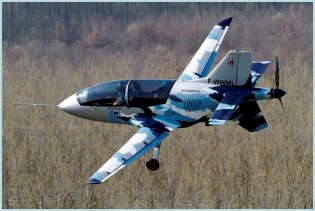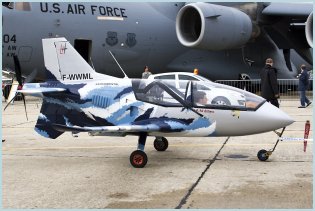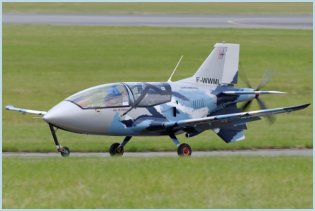LH-10 Ellipse
| a | ||||||||||||||||||||||
|
LH Aviation LH-10 Ellipse light surveillance aircraft
|
||||||||||||||||||||||
|
|
||||||||||||||||||||||
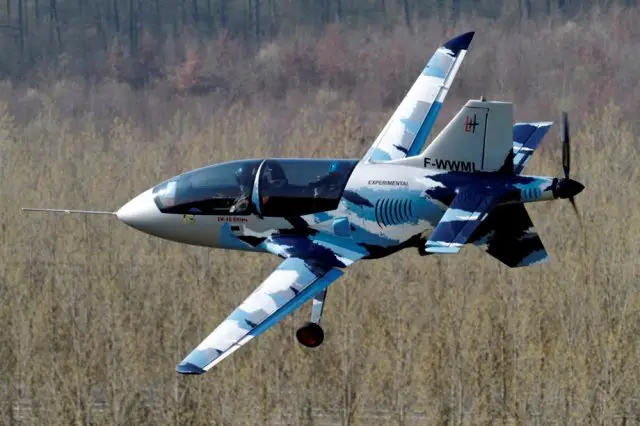 |
||||||||||||||||||||||
|
|
||||||||||||||||||||||
|
The LH-10 Ellipse is a two-seat light aircraft kitplane designed by the France-based aircraft manufacturer LH Aviation. It is a low-wing single-engine pusher configuration with a tandem seating arrangement, and is constructed of composite materials. The plane is marketed in a surveillance configuration as the Grand Duc (eagle-owl). Its low weight and unusual configuration is designed to deliver a very high cruising speed with exceptional fuel economy.
LH-10 Ellipse was tested in summer 2012 by the French Civil Safety (Sécurité civile). The plane was tested and evaluated for the surveillance and the prevention of forest fires. Also, two copies of this small plane built at Melun-Villaroche have been ordered the Benin People's Air Force. The Benin has ordered two "Grand Duc" variantto monitor their coastlines around the capital Porto-Novo. The Grand Duc is a so-called "aerial territory surveillance system" and differs from the original version only in its comprehensive on-board instrumentation including autopilot, equipment for night flying, GPS, Iridium satellite communications, transponder, digital camera, Geobox system for tracking the aircraft from the ground, etc. The first production Ellipse appeared at the June 2011 Paris Air Show, painted in the colours of the Benin People's Air Force. The first unit was delivered to Benin in late 2012 and the second unit was scheduled to be delivered in September 2013. |
||||||||||||||||||||||
| Main Variants | ||||||||||||||||||||||
|
- LH-10 M: variant to be produced in the Kingdom of Maroc by LH Aviation Maroc.
- LH-10 D/ LH-UAV: UAV variant, tactical drone version of the LH-10 with OPV option. It can transport up to 250 kg of payload with an autonomy of 24h. The LH-D can be mounted in less than one hour and is operated by three technicians. |
||||||||||||||||||||||
| Technical Data | ||||||||||||||||||||||
| Design | ||||||||||||||||||||||
|
The airframe and the motorization og the LH-10 Ellipse were carefully designed by aeronautical experts to gives the plane the best performances. The aircraft is build with composite materials that makes it very light. The motor is placed behind the cockpit and moves a pushing propeller. The cockpit section itself is like a glider fuselage, offering very good visibility to the pilot. LH Aviation uses an infusion technique with its composite materials, injecting resins between carbonfibre sheets to create the structures. Kevlar is added on the wing leading edges, the seats and the elevators. The fuselage is created on moulds in two halves and fused together. As a kit, the company says "a beginner" can construct the aircraft in 600h, with the wing and stabiliser detachable "in minutes" for loading on a truck. The tandem cockpit, 26.8 in wide, accommodates pilots up to 265 lbs and 6.39 ft in high comfort. With the throttle in the left hand and a mini-stick in the right hand, the pilot has the best visibility in all directions. The wings and stabilizer can be quickly dismantled in a few minutes by two people, without any tools and without emptying any fuel tank. The airplane can then be loaded onto a trailer.
|
||||||||||||||||||||||
|
Propulsion
|
||||||||||||||||||||||
|
The LH-10 Ellipse is powered with a Rotax 912 ULS, which is a normally aspirated, air- and water-cooled, horizontally opposed four-cylinder, four-stroke, gear reduction-drive engine commonly used on certified aircraft, light sport aircraft, ultralight aircraft and unmanned aerial vehicles. Flying at 370 kilometres per hour – 150 kilometres per hour faster than other planes in its class – it's able to cross the whole of France (1,600 km) in one flight without refuelling, consuming around 18 litres of fuel per hour (between 9l/h in eco and 26l/h). That’s less than 5 litres per 100 kilometres, which is less than the average car. The Ellipse has a fuel tanker capacity of 82 L/22 GAL.
|
||||||||||||||||||||||
|
Avionics
|
||||||||||||||||||||||
|
The standard LH-10 Ellipse is fitted with two EFIS screens for flight and engine data, a Com radio, an intercom and according to local regulations standby instruments: speed, altimeter and engine instruments. The aircraft's instruments have been developed around the principle HOTAS (HOTAS hands-on throttle and stick) management, which places the driver in a modern environment allowing him to devote himself entirely to his mission.
|
||||||||||||||||||||||
| Accessories | ||||||||||||||||||||||
|
The "Grand Duc" version sold to the Benin People's Air Force includes specific on-board instrumentation, such as autopilot, equipment for night flying, GPS, Iridium satellite communications, transponder, digital camera, and Geobox system for tracking the aircraft from the ground. Other versions were presented in 2012, including the LH-10 "Advanced" for monitoring forest fires. It is equipped with a Swedish optronics pod, the DST Otus L170, fitted in the nose and weighing 3 kg. It can transmit images in real time, during day or night. Another variant is to serve as a flying testbed for weapons, including Thales' TDA-4 68 mm guided rockets (2 rockets per basket). Its first flight was due in March 2013.According to LH Aviation, it can also be fitted with two small bombs of 15 kg or two 7.62 mm NATO submachine guns; and then perform close air support. A training version has also been proposed with tandem command controls. The LH-10 Ellipse has a total payload capacity of 250 kg.
|
||||||||||||||||||||||
| Specifications | ||||||||||||||||||||||
|
||||||||||||||||||||||
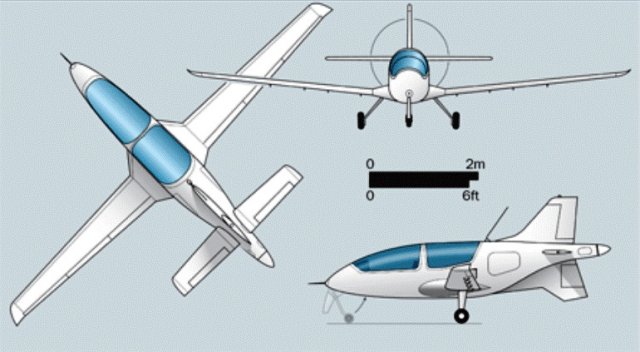 |
||||||||||||||||||||||
|
||||||||||||||||||||||




























